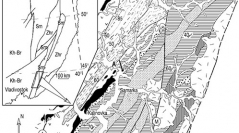

 Geodiversitas
23 (3) - Pages 323-339
Geodiversitas
23 (3) - Pages 323-339Based on a study of several cherty-terrigenous sequences of the Samarka terrane in Sikhote-Alin, comprising lithologic and paleontological analysis, the different age of the transitional layers from marine formations to paleocontinental-margin deposits was established and the succession of marine fragments accretion was restored. The obtained data shows that low structural level of the Samarka accretionary prism is composed of a minimum of four successive tectonostratigraphic units that differ both in age of accreted marine fragments and time of their accretion. Each unit consists of deposits of a paleo-oceanic plates gradually changing above on a section by terrigenous rocks, which further are replaced by an olistostrome. The relatively young pelagic rocks and overlapping terrigenous deposits occur structurally below older deposits. Such structure of the Samarka prism results from a consecutive accretion of the fragments of a different-age sites of a paleo-ocean plate. Radiolarian age data for the accretionary prism indicates that fragments of a Late Permian-Triassic, Early Triassic-Early Jurassic and Early Triassic-Middle Jurassic paleo-oceanic plate were consecutively accreted into the prism.
Sikhote-Alin, Russia, terrane, accretionary prism, accretion, tectonostratigraphy, radiolaria, olistostrome